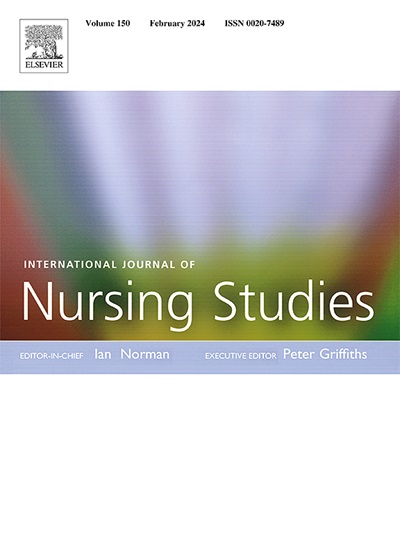Comparative efficacy of interventions for promoting physical activity in people with type 2 diabetes: A systematic review and network meta-analysis
IF 7.1
1区 医学
Q1 NURSING
引用次数: 0
Abstract
Background
Increasing physical activity is recommended as a cornerstone of self-management strategies for diabetes prevention and management. While evidence supporting the effectiveness of various interventions to enhance physical activity in individuals with type 2 diabetes is expanding, there remains a lack of consensus regarding the most effective intervention.
Objective
To compare and rank the efficacy of different interventions in improving physical activity among individuals with type 2 diabetes.
Design
Systematic review and network meta-analysis.
Methods
PubMed, Cochrane Library, EMBASE, Web of Science, China Knowledge Resource Integrated Database, Wanfang Database, Weipu Database, and Chinese Biomedical Database were systematically searched for relevant studies published from the inception of databases until August 4, 2023. Randomized controlled trials evaluating any interventions aimed at improving physical activity (moderate-to-vigorous physical activity or steps per day measured objectively) in individuals with type 2 diabetes were included. The risk of bias was assessed according to the Revised Cochrane risk-of-bias tool for randomized trials (RoB2). A random-effects network meta-analysis model was employed to synthesize all available evidence. The registration number of this study is CRD42023432185.
Results
33 studies involving 6304 participants were included in the quantitative synthesis. In total, the studies assessed 12 different interventions. Sixteen of the 33 studies (48.5 %) met the adapted Cochrane ROB2 for low risk of bias, while five studies were considered to be at high overall risk of bias. Compared to minimal intervention, multi-component interventions (MD 6.43 min/day, 95 % CI 1.85–11.01) had statistically significant effects on improving moderate-to-vigorous physical activity. Additionally, physical activity programme, counselling plus self-help materials, counselling plus Biofeedback, self-help materials plus biofeedback, physical activity programme plus biofeedback, and multi-component interventions had statistically significant effects on improving daily step counts, with MDs ranging from 1672 to 2504 steps per day in individuals with type 2 diabetes.
Conclusions
A combination of more than two intervention components appears required to increase physical activity. Counselling, physical activity programme, and biofeedback may be effective ingredients of such combinations, especially to increase the daily step count, among individuals with type 2 diabetes. However, the findings should be interpreted cautiously due to the limited number of studies, small sample sizes, and inconsistencies between outcome measures and comparison types. Further research is needed to strengthen the evidence base for clinical decision-making and to identify the most effective intervention combinations.
促进2型糖尿病患者身体活动的干预措施的比较疗效:系统综述和网络荟萃分析
背景:增加身体活动被推荐为糖尿病预防和管理自我管理策略的基石。虽然越来越多的证据支持各种干预措施增强2型糖尿病患者身体活动的有效性,但对于最有效的干预措施仍缺乏共识。目的比较不同干预措施对改善2型糖尿病患者身体活动的效果并进行排名。设计系统回顾和网络荟萃分析。方法系统检索spubmed、Cochrane Library、EMBASE、Web of Science、中国知识资源综合数据库、万方数据库、唯普数据库、中国生物医学数据库自建库至2023年8月4日发表的相关研究。随机对照试验评估任何旨在改善2型糖尿病患者身体活动的干预措施(客观地测量中等到剧烈的身体活动或每天的步数)。根据修订后的Cochrane随机试验风险偏倚工具(RoB2)评估偏倚风险。采用随机效应网络元分析模型综合所有可用证据。本研究的注册号为CRD42023432185。结果共纳入33项研究,6304名受试者。这些研究总共评估了12种不同的干预措施。33项研究中有16项(48.5%)符合低偏倚风险的Cochrane ROB2,而5项研究被认为具有高偏倚风险。与最小干预相比,多组分干预(MD为6.43分钟/天,95% CI为1.85-11.01)在改善中高强度体力活动方面具有统计学意义。此外,体育活动计划、咨询+自助材料、咨询+生物反馈、自助材料+生物反馈、体育活动计划+生物反馈和多组分干预对改善2型糖尿病患者每日步数有统计学显著影响,MDs范围为每天1672至2504步。结论:增加体力活动需要两种以上干预措施的组合。咨询、体育活动规划和生物反馈可能是这种组合的有效成分,特别是增加2型糖尿病患者的每日步数。然而,由于研究数量有限,样本量小,结果测量和比较类型之间不一致,研究结果应谨慎解释。需要进一步的研究来加强临床决策的证据基础,并确定最有效的干预组合。
本文章由计算机程序翻译,如有差异,请以英文原文为准。
求助全文
约1分钟内获得全文
求助全文
来源期刊
CiteScore
15.00
自引率
2.50%
发文量
181
审稿时长
21 days
期刊介绍:
The International Journal of Nursing Studies (IJNS) is a highly respected journal that has been publishing original peer-reviewed articles since 1963. It provides a forum for original research and scholarship about health care delivery, organisation, management, workforce, policy, and research methods relevant to nursing, midwifery, and other health related professions. The journal aims to support evidence informed policy and practice by publishing research, systematic and other scholarly reviews, critical discussion, and commentary of the highest standard. The IJNS is indexed in major databases including PubMed, Medline, Thomson Reuters - Science Citation Index, Scopus, Thomson Reuters - Social Science Citation Index, CINAHL, and the BNI (British Nursing Index).

 求助内容:
求助内容: 应助结果提醒方式:
应助结果提醒方式:


